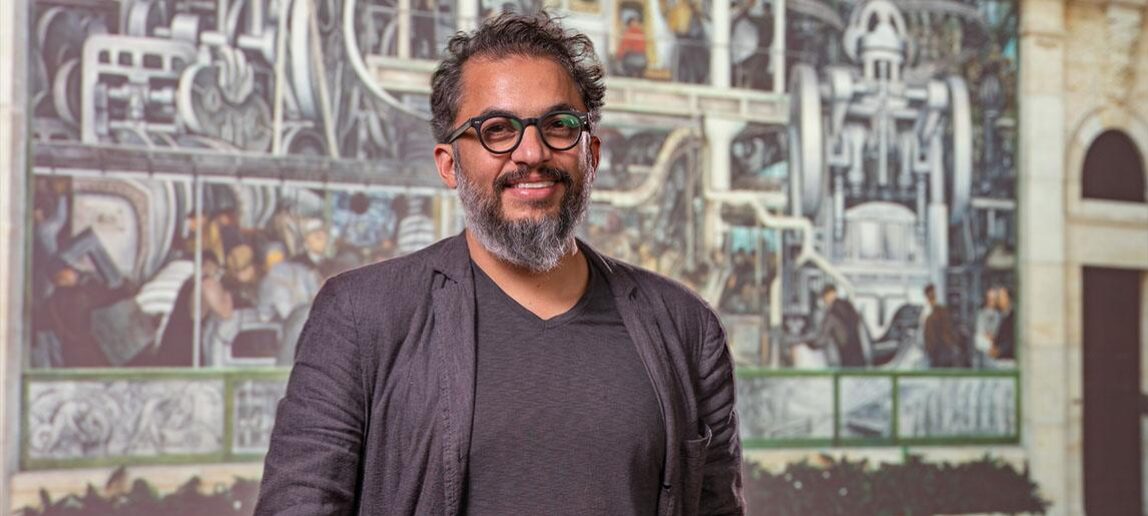Professor finds profitable uses for industrial byproducts
Not many people can say they have a love-hate relationship with waste.
An exception is Ahmed K. Ali, a Texas A&M associate professor of architecture who considers waste in his work and research. He has even dubbed himself “the wasteman,” as he says the moniker helps him start critical conversations around design, architecture, and sustainability.
“I love waste because I make use of it, but I also hate it at the same time and don’t want people to produce more of it,” he said.
Ali is on a mission to find creative and attractive solutions to industrial waste-flows and by-products, ways to limit waste in design, and move the world’s economy from one that produces billions of tons of waste, to one in which resources are used as long as possible for maximum value — the circular economy.
The Rubbish Reality
Waste is a modern idea; it’s not found in nature. We use more than 100 billion tons of raw materials worldwide each year in manufacturing,” said Ali, the founding director of Texas A&M’s Resource-Based Research Design Lab. “Most of it goes to landfills. It’s not sustainable.”
Until recently, many companies simply sold their industrial waste and by-products as a commodity. It
once was a $57 billion industry in the United States. But new policies in Asian countries, the largest buyer of U.S. industrial waste, now restrict those imports, and American companies are having to deal with their own mess.
Other established recycling practices often use substantial energy, go unused or overlooked because they’re hidden away or seen as more expensive or a bigger hassle than they’re worth. This is why, according to Ali, the attractiveness of waste-based solutions is imperative.
“Sustainability has to be beautiful,” said Ali. “When we talk about using our existent resources, we must bring the idea of beauty to the forefront of the story.”
A Living Wall
A proof of concept of Ali’s ideas is a modular Living Wall, an innovative “green” wall made of galvanized sheet metal by-products, called offal, generated by the millions in the automotive industry.
With a $300,000 competitive grant from Texas A&M’s Tier One program in 2017, Ali and Texas A&M faculty Bruce Dvorak, associate professor of landscape architecture, who helped plan the custom irrigation system and sourced Texas native plants for the project, and Jorge Alvarado, professor of engineering technology, created a leap forward in “green” wall design and technology.
The partnership resulted in 300 diamond-shaped planters made of 20 tons of by-products sheet metal from General Motors Company on a custom built, 14 x 18-foot frame on building B of Texas A&M’s Langford Architecture Center. The invention is modular and can be used as a building skin.
In addition to the planters’ unique shape, design, and material, the frame they’re on is connected to Langford B at only a few points; because the frame holds the planters slightly away from the building, acting as a double building envelope, the Langford B wall is protected from damage caused by water from the planters or traditional felt or textile material in planters. The entire wall system is designed to be easily accessible, changeable, and sustainable. Planters are supported only by the law of gravity.

Inspired Design
“As soon as the wall was up, it generated critical research questions from scholars across campus,” said Ali. “People from agriculture wanted to work with us to see how they could grow food vertically in cities. Water resources engineering wanted to collaborate on rainwater harvesting and wastewater irrigation. Other researchers from material sciences and engineering said they wanted to study the effects of bending sheet metal and energy savings.”
At the same time, students walking by started to take photos at the wall, and it became a popular campus picture spot. The buzz created more inquiries about the project, which has been featured in dozens of articles and journals.
This is the power of beautiful design, according to Ali.
“The waste discourse layer is a hidden part of the story that you don’t find out about until you ask questions,” said Ali. “The most important story is that it is beautiful, functional and it works. There is no subjectivity. Even if the plants are dormant in a season, it is still beautiful because it acts as a building skin. This beauty inspires further research and curiosity.”
Ali said innovative design thinking can inspire positive change, help solve global problems and build future generations of consciously-oriented designers.
“There is a misconception about architects that we are just responsible for creating a nice drawing or rendering,” said Ali. “But that is not all we are capable of. We can tackle some of the most challenging problems of the world through design thinking and with our uniquely investigative architectural education, which allows us to think creatively about out of the box solutions.”
High Rise Dreams
Ali has filed patents for the Living Wall system, and is in talks with Zahner, a world-renowned architectural metal surfaces company, about commercializing the product.
This could allow Living Wall systems to be incorporated with building skin systems into large-scale construction projects but also potentially available at home improvement stores like Home Depot or Lowes for smaller-scale use.
“We want to make this available to the public,” Ali said. “As a product in the market you could perhaps buy 50 of them and use them in your backyard or on your exterior walls for planting to grow vegetables and flowers.”
Reforging Supply Chains
As more and more people move to cities, Ali said these types of systems, which could be implemented along the sides of apartments or city buildings, could help grow food for residents instead of relying on already taxed shipping and transportation lines.
“The pandemic showed how fragile the supply chain is,” Ali said. “If you’re in an apartment in Dallas and the only way to get food is at the grocery store that relies on highway transportation, you could be in trouble. If we could grow our own food on city walls, and reuse material to reduce cost and make these systems affordable — it’s very exciting.”
To further explore global interdisciplinary innovations in the circular economy paradigm shift, Ali and his partners were awarded a $50,000 Texas A&M Global Engagement Grant to develop a Global Collaborative Learning Environment for Architecture Product Innovation and Sustainable Manufacturing.
He’s been awarded additional T3 President’s Excellence Fund grants to explore other circular economy projects, including $32,000 to work on solutions for college student homelessness and $37,000 for a recently completed project for alternate uses for plastic waste technology, namely transforming computer microchip carriers known as matrix trays into building products.
His projects are also regularly funded by the industry including General Motors, Zahner and the United States Business Council for Sustainable Development.
Creative Design Minds
In his design studios, Ali presents waste-related, theoretical, and real-life challenges to teach creative design thinking to his students.
While architects typically design and then figure out materials, Ali uses something he calls “synergistic means-oriented design” to put the materials first, such as manufacturing waste, and then identify an application to use it.
“When you give students this type of project-based assignments, they are excited to think about the problem, rather than just the goal of designing a building,” he said. “When they start with the waste problem, they have to learn about things that aren’t just architecture. They investigate ecology, manufacturing, steel production, industrial symbiosis, etcetera, before they design and start to employ creative design thinking to come up with solutions.”
Ali said the difference is “vast” when working with architecture students versus others.
“The design education allows you to be critical, incredibly creative, and constantly push boundaries,” he said.
Ali hopes to encourage that way of thinking in undergraduate and graduate programs by collaborating with colleagues in engineering, agriculture, and business on an interdisciplinary degree program that will allow students from all colleges to collaborate and learn from each other for ideas to create a better, more circular economic future.
“This will help them when they graduate to be entrepreneurs and to have the skill to think about resources and positive impact on communities as they design or consider architectural projects,” he said.
Everyone Wins
Designing with waste-flow or by-product materials first has multiple beneficial applications, said Ali.
“Finding ways to use manufacturing waste can generate jobs and make new opportunities for people to start their own businesses,” Ali said.
“We aren’t just helping the environment, we are trying to help everyone win in this scenario, even those producing the waste,” he said. “Right now, factories see no value in it, but there could be a multifaceted impact not just for the environment but for the economy.”
Ali hopes to have more industries become open to creative, new uses of manufacturing waste.
“We can create solutions for your waste that you would never think of,” Ali said.
Ahmed K. Ali
Associate Professor // Harold L. Adams Endowed Professor of Architecture
979.862.5863 Email Ahmed K. Ali

